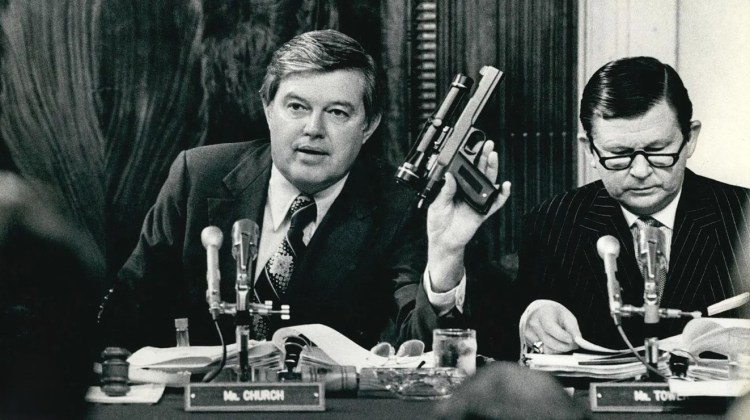In the pantheon of Cold War madness, few relics are as bizarre and terrifying as the CIA’s heart attack gun—a piece of deadly American ingenuity that could kill a man without so much as leaving a trace. This wasn’t just another spook’s fever dream or a wild-eyed invention of Hollywood. No, this was real, crafted in the darkened labs of Langley and wielded by a paranoid government determined to snuff out enemies without the messy business of accountability.
The Perfect Kill
Picture this: a modified Colt M1911, the kind of steel beast John Browning himself would raise a toast to, now retooled to fire frozen darts laced with shellfish toxin. No loud bangs, no messy blood spray—just a soft puff of air and a tiny puncture wound no bigger than a mosquito bite. The victim? Dead in seconds from cardiac arrest, their death chalked up to an unfortunate roll of the biological dice.
The brain trust behind this monstrosity was a cabal of scientists tasked with creating weapons that didn’t just kill but erased all evidence of the kill. Mary Embree, a CIA researcher, spilled the beans years later, admitting she was ordered to find poisons that could slip through an autopsy like a ghost through a wall. What they found in the depths of shellfish toxin research was pure venom cloaked in plausible deniability.
It’s called saxitoxin (STX), and it is one of the most potent natural toxins known to humankind. A lethal dose for humans is estimated to be merely 0.57mg if ingested. It was originally sourced from butter clams, but that’s all I’m going to say about that. Due to its extreme toxicity, STX is classified as a Schedule 1 Chemical Warfare Agent. Basically, it very quickly shuts down the entire nervous system, resulting in death in minutes due to respiratory failure.
The frozen dart used as a carrier for the poison was said to be the width of a human hair. It supposedly left only a tiny, nearly undetectable red mark on the skin.
The Church Committee
The heart attack gun strutted onto the public stage in 1975 during the infamous Church Committee hearings. Senator Frank Church, a man with a face carved from moral outrage, held the weapon aloft like a dark wizard unveiling his wand. The hearings were a parade of paranoia, revealing America’s shadow war tactics and the CIA’s laundry list of sins. From coup plots to biological warfare, the heart attack gun was the star—proof that Langley wasn’t just playing defense but mastering the art of silent assassination.
Church described it as the perfect crime tool: no fingerprints, no bullet casings, and no witnesses left to testify. If you needed a man gone—whether he was sipping tea in Tehran or preaching revolution in the Congo—this was your weapon. Perhaps in an attempt to confuse future generations, Church described the delivery method as a “nondiscernible microbionoculator.”.
In the pantheon of Cold War madness, few relics are as bizarre and terrifying as the CIA’s heart attack gun—a piece of deadly American ingenuity that could kill a man without so much as leaving a trace. This wasn’t just another spook’s fever dream or a wild-eyed invention of Hollywood. No, this was real, crafted in the darkened labs of Langley and wielded by a paranoid government determined to snuff out enemies without the messy business of accountability.
The Perfect Kill
Picture this: a modified Colt M1911, the kind of steel beast John Browning himself would raise a toast to, now retooled to fire frozen darts laced with shellfish toxin. No loud bangs, no messy blood spray—just a soft puff of air and a tiny puncture wound no bigger than a mosquito bite. The victim? Dead in seconds from cardiac arrest, their death chalked up to an unfortunate roll of the biological dice.
The brain trust behind this monstrosity was a cabal of scientists tasked with creating weapons that didn’t just kill but erased all evidence of the kill. Mary Embree, a CIA researcher, spilled the beans years later, admitting she was ordered to find poisons that could slip through an autopsy like a ghost through a wall. What they found in the depths of shellfish toxin research was pure venom cloaked in plausible deniability.
It’s called saxitoxin (STX), and it is one of the most potent natural toxins known to humankind. A lethal dose for humans is estimated to be merely 0.57mg if ingested. It was originally sourced from butter clams, but that’s all I’m going to say about that. Due to its extreme toxicity, STX is classified as a Schedule 1 Chemical Warfare Agent. Basically, it very quickly shuts down the entire nervous system, resulting in death in minutes due to respiratory failure.
The frozen dart used as a carrier for the poison was said to be the width of a human hair. It supposedly left only a tiny, nearly undetectable red mark on the skin.
The Church Committee
The heart attack gun strutted onto the public stage in 1975 during the infamous Church Committee hearings. Senator Frank Church, a man with a face carved from moral outrage, held the weapon aloft like a dark wizard unveiling his wand. The hearings were a parade of paranoia, revealing America’s shadow war tactics and the CIA’s laundry list of sins. From coup plots to biological warfare, the heart attack gun was the star—proof that Langley wasn’t just playing defense but mastering the art of silent assassination.
Church described it as the perfect crime tool: no fingerprints, no bullet casings, and no witnesses left to testify. If you needed a man gone—whether he was sipping tea in Tehran or preaching revolution in the Congo—this was your weapon. Perhaps in an attempt to confuse future generations, Church described the delivery method as a “nondiscernible microbionoculator.”.
A Grim Legacy
It’s hard not to admire the cold, mechanical genius of it all. But let’s be clear: this wasn’t just a weapon; it was a moral sinkhole. The heart attack gun embodied everything the Cold War was about—power without consequence, action without oversight, murder without justice.
Did the CIA ever actually use it? Who knows? The spooks keep their secrets, and the dead don’t talk. Maybe it took out some unlucky despot or silenced a whistleblower. Or maybe it was just a boogeyman, a ghost gun designed to scare the hell out of foreign operatives and domestic critics alike.
Paranoia Meets Precision
The heart attack gun stands as a testament to a time when the line between genius and madness blurred into a haze of cigarette smoke and classified memos. It’s a reminder that the real world of espionage is far darker and stranger than any spy thriller. In the Cold War’s theater of paranoia, this gun was the perfect prop—a silent killer for a silent war.
And somewhere in the shadows, you can bet there’s a successor to the heart attack gun. Maybe it’s even deadlier. It’s probably already in use. But one thing’s for damn sure: as long as men wage secret wars, the tools of the trade will only get weirder, and the bodies will keep piling up in the shadows.



